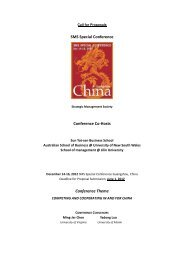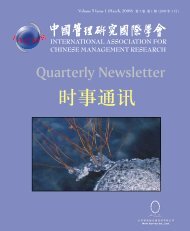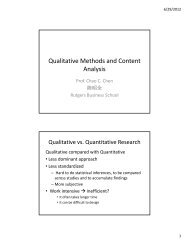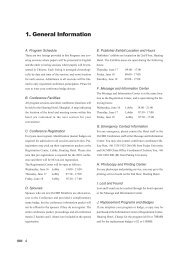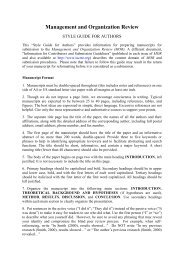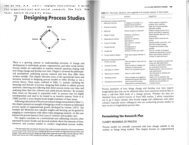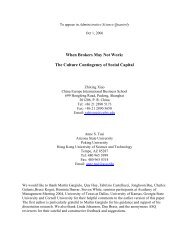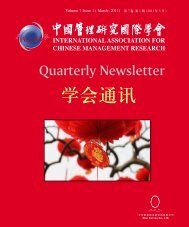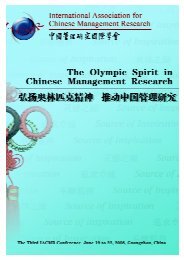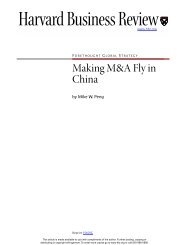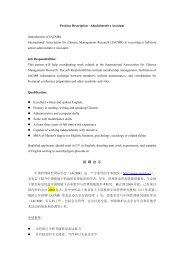Presentation of Prof. Andrew Van de Ven - iacmr
Presentation of Prof. Andrew Van de Ven - iacmr
Presentation of Prof. Andrew Van de Ven - iacmr
- No tags were found...
Create successful ePaper yourself
Turn your PDF publications into a flip-book with our unique Google optimized e-Paper software.
Qualitative Methods for Creative ProblemFormulation and Theory BuildingIACMR Research PanelAOM Boston, August 5, 2012<strong>Andrew</strong> H. <strong>Van</strong> <strong>de</strong> <strong>Ven</strong>University <strong>of</strong> MinnesotaFor sli<strong>de</strong>s: http://umn.edu/~avan<strong>de</strong>veIACMR中 国 管 理 研 究 国 际 学 会 International Association for Chinese Management ResearchToward ActionableKnowledge追 求 诸 于 行 动 的 知 识Anne Tsui CallFor Shift inResearch Focus研 究 关 注 点 的 转 移paper-based基 于 文 献theory-testing理 论 验 证Publications文 章 发 表Rigor严 谨Method方 法Phenomenonbased基 于 现 象Un<strong>de</strong>rstandingAnd theory building理 解 构 建Impact影 响 力RelevanceAnd Rigor切 题Philosophy科 学 哲 学www.<strong>iacmr</strong>.org1
Suggestions for Developing ActionableKnowledge for Theory & Practice1. Practice engaged scholarshiphi2. Ground the subject/topic in reality3. Compare plausible alternative mo<strong>de</strong>ls4. Build strong arguments for claims5. Outline <strong>of</strong> paper Introductory Paragraphs8/24/20121. Practice Engaged ScholarshipClaim: We can increase the likelihood <strong>of</strong> advancingknowledge for science and practice by involvingpractitioners and other stakehol<strong>de</strong>rs in four steps <strong>of</strong>a study:1. Ground problem/question in reality up close &from afar.2. Develop alternative theories to address thequestion.3. Collect evi<strong>de</strong>nce to compare mo<strong>de</strong>ls <strong>of</strong>theories.4. Communicate & apply findings to address theproblem/question.8/24/20122
1. Practice Engaged ScholarshipStudy Context: Research problem, purpose, perspectiveResearch DesignDevelop variance or processmo<strong>de</strong>l to study theoryEngage methods experts & peopleproviding access & informationCriterion – Truth (Verisimilitu<strong>de</strong>)Mo<strong>de</strong>lTheory BuildingCreate, elaborate & justify a theoryby abduction, <strong>de</strong>duction & inductionEngage knowledge experts inrelevant disciplines & functionsCriterion - Validity8/24/2012SolutionProblem SolvingCommunicate, interpret & negotiatefindings with inten<strong>de</strong>d audience.Engage inten<strong>de</strong>d audienceto interpret meanings & usesCriterion - ImpactIterate& FitRealityTheoryProblem FormulationSituate, ground, diagnose & inferthe problem up close and from afarEngage those who experience& know the problemCriterion - Relevance<strong>Van</strong> <strong>de</strong> <strong>Ven</strong>, Engaged Scholarship, Oxford .2007Book Chapters1. Engaged Scholarship in aPr<strong>of</strong>essional School2. Philosophy <strong>of</strong> Science3. Problem Formulation4. Theory Building5. Process and Variance Mo<strong>de</strong>ls6. Designing g Variance Studies7. Designing Process Studies8. Communicating & Using ResearchKnowledge9. Practicing Engaged Scholarship8/24/20123
2. Ground Your Topic in Reality1. What is your research problem and question?- Address who? what? where? when? why? & how? theproblem exists:a. up close -- in particular with example, anecdoteor experienceb. from afar -- in general with data on prevalence& context <strong>of</strong> problem2. What is your conjecture or hunch for answering thisresearch question? Is your answer any better than the status quo or acompeting plausible alternative answer?8/24/2012Abductive Process <strong>of</strong> Creative Inference1. Surprised by an anomaly, problem or puzzle2. Analyze/verify the anomaly3. My anomaly is gone if . . . . . . . .• a creative germ• a hunch, conjecture,• a half-baked i<strong>de</strong>a4. Refine the conjecture and build the theory Go beyond the information given8/24/20124
Edmondson’s ResearchTrianglePhenomenonDataTheories, Mo<strong>de</strong>lsEdmondson, A.C. 2009. “Crossing Boundaries to Investigate Problems in the Field: An Approach to Useful Research,”In E. Lawler & S. Mohrman (eds). Doing Research that is Useful for Theory and Practice – 25 Years Later, Berrett-Kohler98/24/20123. Consi<strong>de</strong>r Plausible Alternative Mo<strong>de</strong>lsStatistical Generalization – Making inferences to population based on sample dataas done in sampling units in survey research (level 1)Analytical Generalization – Making inferences to a theory or rival theory (level 2)Like experiments, case studies should be usedto generalize to plausible alternative theories.Yin, R. K. (2009). Case study research: Design and methods, 4th ed. Thousand Oaks: Sage., p.39.5
Building Theory from Case StudyStepGetting StartedSelecting CasesInstrumentsEntering fieldAnalyzing dataEnfolding literatureActivitySituate problem/phenomenon: perspective, focus, level, scopeDefine research question; start with journalist’s questionsUse theoretical/analytical, not statistical population samplingTriangulate; use multiple data collection methodsOverlap data collection and analysis to sharpen concepts-- If foggy at first, they will <strong>de</strong>fog with field workWithin-case for up-close particulars; Cross-case for patternsCompare similar and conflicting literatureShapinghypothesesReaching ClosureIterate above three steps; search for “why?” and “how?”Use abductive logic to <strong>de</strong>velop alternative conjecturesTheoretical saturation on research questionGo beyond the information given (Bruner)Adapted from Kathleen Eisenhardt, Building Theories from Case Study Research, AMR, 14, 4 (1989), p. 533.Eisenhardt & Graebner, Theory Building from Cases: Opportunities and Challenges, AMJ, 50 (2007): 25-324. Build Strong Arguments for your ClaimsBackground– the problem, question, context <strong>of</strong> the claimClaim-Proposition-HypothesisReasons- Major premise- Logic un<strong>de</strong>rlying claim- GroundsEvi<strong>de</strong>nce-minor premise- data backing reason-warrantsQualifiers- when claim holds ods- assumptions- boundary conditions- contingenciesReservationsLimitations - Grounds for Rebuttal- Logical refutations: validity- Empirical refutations: truth- Cogency <strong>of</strong> argument: persuasivenessStephen Toulmin, The Uses <strong>of</strong> Argument, Updated Edition. Cambridge: Cambridge Univ. Press, 20038/24/20126
Shape your argument with tree diagramSource: John Ramage & John Bean, Writing Arguments, Third Edition, Boston, MA: Allyn-Bacon, 1995:73.5. Introductory Paragraphs <strong>of</strong> Your Paper1. Ground The issue up close - examplepe2. The issue from afar – its pervasiveness &context3. The research question examined here4. My answer – proposition/theory5. Argument – My answer is better thanalternative status quo answer because…6. The next sections <strong>of</strong> paper proceed asfollows….8/24/20127
Your thoughts please!1. What is your researchproblem & question.-- Give example.2. What is your answer?-- Better than status quo?3. How <strong>de</strong>sign study?4. How communicate andimplement your findings?5. Knowledge for whom? Forwhat?8/24/20128



